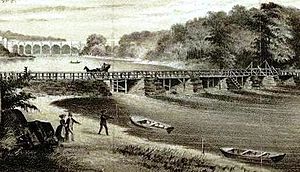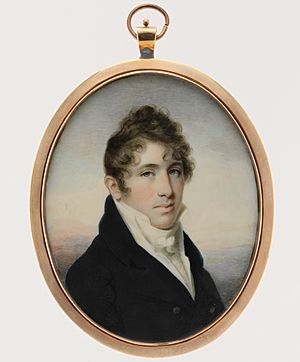Macombs Dam facts for kids
The Macombs Dam (pronounced mə-KOOMZ) was a special structure that worked as both a dam and a bridge. It stretched across the Harlem River in New York City, connecting Manhattan and the Bronx. This dam and bridge existed for about 44 years, from around 1814 to 1858.
Later, a new bridge called the Central Bridge replaced it. Since 1890, the Macombs Dam Bridge has stood in the same spot. It's still there today!
Contents
History of Macombs Dam
Building the Dam and Bridge
In 1813, a man named Robert Macomb asked the New York State government for permission to build a dam. He wanted the dam to hold water for a special type of mill called a tide mill. This mill would use the power of the tides to grind grain.
Many important citizens in the area knew Macomb would likely get his wish. So, they asked the city to let him build a bridge as part of the dam too. The city agreed, and Macomb was allowed to charge a small fee, called a toll, to people who used the bridge. Half of this money went to the city to help educate poor children.
The dam started working in 1814, and the bridge was finished two years later, in 1816.
Problems with the Dam
When Macomb got permission to build the dam, he had to include a lock. A lock is like a water elevator that helps boats move from one water level to another. This lock was supposed to keep the river open for boats to pass through.
However, the lock was very small, only about 7 feet by 7 feet. This meant only tiny boats could use it, which limited how many boats could travel on the river. By the late 1820s, parts of the lock were even filled with stones. This made it very dangerous for boats to pass, and some people even lost their lives trying to get through.
Taking Down the Dam
By 1839, many local citizens were very upset. The dam was still blocking the river, and there were plans for another structure, the Croton Aqueduct, which would block it even more. They decided to take action.
A group of about 100 men, led by Lewis G. Morris, sailed to the dam. They asked the bridge keeper to let their boat pass. When he refused, Morris's men used axes to break open parts of the dam and bridge. This act of peaceful protest, called civil disobedience, allowed their boat to pass. They came back several times to remove more of the dam.
The courts later agreed with their actions. They ruled that the dam was a "public nuisance" because it blocked river travel. The court said that New York State should not have allowed the bridge to be built in the first place, because the federal government is in charge of navigable rivers.
On April 16, 1858, the city passed a law to remove the dam completely. By 1861, both the dam and bridge were gone.
What Came Next
The Macombs Dam was replaced by the Central Bridge, which did not charge a toll. Then, in 1890, the current Macombs Dam Bridge was built in the same spot. This bridge is now one of the oldest major bridges in New York City. Only the Brooklyn Bridge and the Washington Bridge are older.
Today, the Macombs Dam is remembered in the name of Macombs Dam Park. This park was rebuilt in 2010 when the new Yankee Stadium was constructed nearby.



